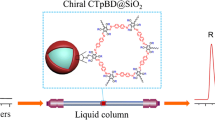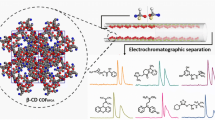Abstract
The separation of amino acid (AA) enantiomers shows significance for chemistry, food, and biology, but remains challenging due to their similar properties. A promising nanoporous chiral covalent organic framework (COF) as a stationary phase for high-performance liquid chromatography (HPLC) suffers from the irregularity and widely distributed particle size of the chiral COF. Herein, we show the facile preparation of a chiral COF-monolith as a stationary phase for HPLC enantiomeric separation of AAs via orthogonal experiments. The CTzDa-monolith is prepared by the incorporation of the model chiral COF named CTzDa into the porous poly(ethylene dimethacrylate-co-methacrylate) monolith and reveals great permeability and mechanical stability. The corresponding CTzDa-monolithic column gives better chiral HPLC separation of AAs than the commercial Poroshell 120 chiral-T column. Thermal dynamic analysis and molecular docking calculations imply the involvement of stereoscopic hydrogen, π-π, and van der Waals interactions between the CTzDa and AAs during HPLC enantioseparation. The facile incorporation of the chiral COF into the porous monolith will promote the potential of a chiral COF as a stationary phase for HPLC.
Graphical abstract





Similar content being viewed by others
References
Blaskovich MA. Unusual amino acids in medicinal chemistry. J Med Chem. 2016;59:10807–36.
Meister A. Biochemistry of the amino acids. Second ed. London: Academic Press; 2012.
Zhao CJ, Schieber A, Gänzle MG. Formation of taste-active amino acids, amino acid derivatives and peptides in food fermentations–a review. Food Res Int. 2016;89:39–47.
Bastings JJ, van Eijk HM, Olde Damink SW, Rensen SS. D-amino acids in health and disease: a focus on cancer. Nutrients. 2019;11:2205.
Sardella R, Lisanti A, Marinozzi M, Ianni F, Natalini B, Blanch GP, et al. Combined monodimensional chromatographic approaches to monitor the presence of D-amino acids in cheese. Food Control. 2013;34:478–87.
Rocco A, Aturki Z, Fanali S. Chiral separations in food analysis. TrAC, Trends Anal Chem. 2013;52:206–25.
Herrero M, Ibáñez E, Martín-Álvarez PJ, Cifuentes A. Analysis of chiral amino acids in conventional and transgenic maize. Anal Chem. 2007;79:5071–7.
Lammerhofer M. Chiral recognition by enantioselective liquid chromatography: mechanisms and modern chiral stationary phases. J Chromatogr A. 2010;1217:814–56.
Okamoto Y, Ikai T. Chiral HPLC for efficient resolution of enantiomers. Chem Soc Rev. 2008;37:2593–608.
Knežević A, Novak J, Vinković V. New brush-type chiral stationary phases for enantioseparation of pharmaceutical drugs. Molecules. 2019;24:823.
Fernandes C, Tiritan ME, Pinto M. Small molecules as chromatographic tools for HPLC enantiomeric resolution: Pirkle-type chiral stationary phases evolution. Chromatographia. 2013;76:871–97.
Yao X, Zheng H, Zhang Y, Ma X, Xiao Y, Wang Y. Engineering thiol–ene click chemistry for the fabrication of novel structurally well-defined multifunctional cyclodextrin separation materials for enhanced enantioseparation. Anal Chem. 2016;88:4955–64.
Wang Y, Zhuo S, Hou J, Li W, Ji Y. Construction of β-Cyclodextrin covalent organic framework-modified chiral stationary phase for chiral separation. ACS Appl Mater interfaces. 2019;11:48363–9.
Cui YY, Yang CX, Yan XP. Thiol-yne click post-modification for the synthesis of chiral microporous organic networks for chiral gas chromatography. ACS Appl Mater interfaces. 2020;12:4954–61.
Corella-Ochoa MN, Tapia JB, Rubin HN, Lillo V, González-Cobos J, Núñez-Rico JL, et al. Homochiral metal–organic frameworks for enantioselective separations in liquid chromatography. J Am Chem Soc. 2019;141:14306–16.
Navarro-Sánchez J, Argente-García AI, Moliner-Martínez Y, Roca-Sanjuán D, Antypov D, Campíns-Falcó P, et al. Peptide metal–organic frameworks for enantioselective separation of chiral drugs. J Am Chem Soc. 2017;139:4294–7.
Cote AP, Benin AI, Ockwig NW, O'Keeffe M, Matzger AJ, Yaghi OM. Porous, crystalline, covalent organic frameworks. Science. 2005;310:1166–70.
Waller PJ, Gandara F, Yaghi OM. Chemistry of covalent organic frameworks. Acc Chem Res. 2015;48:3053–63.
Huang N, Wang P, Jiang D. Covalent organic frameworks: a materials platform for structural and functional designs. Nat Rev Mater. 2016;1:16068.
Qian HL, Meng FL, Yang CX, Yan XP. Irreversible amide-linked covalent organic framework for selective and ultrafast gold recovery. Angew Chem Int Ed. 2020;59:17607–13.
Han X, Yuan C, Hou B, Liu L, Li H, Liu Y, et al. Chiral covalent organic frameworks: design, synthesis and property. Chem Soc Rev. 2020:6248–72.
Qian HL, Yang CX, Yan XP. Bottom-up synthesis of chiral covalent organic frameworks and their bound capillaries for chiral separation. Nat Commun. 2016;7:12104.
Han X, Huang J, Yuan C, Liu Y, Cui Y. Chiral 3D covalent organic frameworks for high performance liquid chromatographic enantioseparation. J Am Chem Soc. 2018;140:892–5.
Zhang S, Zheng Y, An H, Aguila B, Yang CX, Dong Y, et al. Covalent organic frameworks with chirality enriched by biomolecules for efficient chiral separation. Angew Chem Int Ed. 2018;57:16754–9.
Liu LH, Yang CX, Yan XP. Methacrylate-bonded covalent-organic framework monolithic columns for high performance liquid chromatography. J Chromatogr A. 2017;1479:137–44.
Jandera P. Advances in the development of organic polymer monolithic columns and their applications in food analysis—a review. J Chromatogr A. 2013;1313:37–53.
Morris GM, Huey R, Lindstrom W, Sanner MF, Belew RK, Goodsell DS, et al. AutoDock4 and AutoDockTools4: automated docking with selective receptor flexibility. J Comput Chem. 2009;30:2785–91.
Chen ML, Li LM, Yuan BF, Ma Q, Feng YQ. Preparation and characterization of methacrylate-based monolith for capillary hydrophilic interaction chromatography. J Chromatogr A. 2012;1230:54–60.
Liu F, Qian HL, Yang C, Yan XP. Room-temperature preparation of a chiral covalent organic framework for the selective adsorption of amino acid enantiomers. RSC Advances. 2020;10:15383–6.
Sheng Z, Xie S. Pan C Probability theory and mathematical statistics. 3rd Version ed. Hangzhou: Zhejiang University Press; 2001.
Lin R, Diao X, Ma T, Tang S, Chen L, Liu D. Optimized microporous layer for improving polymer exchange membrane fuel cell performance using orthogonal test design. Appl Energ. 2019;254:113714.
van Deemter JJ, Zuiderweg FJ, Klinkenberg A. Longitudinal diffusion and resistance to mass transfer as causes of nonideality in chromatography. Chem Eng Sci. 1956;5:271–89.
Zhang H, Ou J, Liu Z, Wang H, Wei Y, Zou H. Preparation of hybrid monolithic columns via “one-pot” photoinitiated thiol–acrylate polymerization for retention-independent performance in capillary liquid chromatography. Anal chem. 2015;87:8789–97.
Küsters E, Loux V, Schmid E, Floersheim P. Enantiomeric separation of chiral sulphoxides: screening of cellulose-based sorbents with particular reference to cellulose tribenzoate. J Chromatogr A. 1994;666:421–32.
Wang T, Wang J, Zhang C, Yang Z, Dai X, Cheng M, et al. Metal-organic framework MIL-101(Cr) as a sorbent of porous membrane-protected micro-solid-phase extraction for the analysis of six phthalate esters from drinking water: a combination of experimental and computational study. Analyst. 2015;140:5308–16.
Ma M, Du Y, Zhang L, Gan J, Yang J. β-Cyclodextrin covalent organic framework–modified organic polymer monolith as a stationary phase for combined hydrophilic and hydrophobic aqueous capillary electrochromatographic separation of small molecules. Microchimi Acta. 2020;187:1–11.
Funding
The authors are grateful for the support from the National Natural Science Foundation of China (No. 21804055, 21775056, 22076066), the Natural Science Foundation of Jiangsu Province (No. BK20180585), the Fundamental Research Funds for the Central Universities (No. JUSRP221002), the National First-class Discipline Program of Food Science and Technology (No. JUFSTR20180301), and the Program of “Collaborative Innovation Center of Food Safety and Quality Control in Jiangsu Province.”
Author information
Authors and Affiliations
Corresponding author
Ethics declarations
Conflict of interest
The authors declare no competing interests.
Additional information
Published in the topical collection featuring Promising Early-Career (Bio)Analytical Researchers with guest editors Antje J. Baeumner, María C. Moreno-Bondi, Sabine Szunerits, and Qiuquan Wang.
Publisher’s note
Springer Nature remains neutral with regard to jurisdictional claims in published maps and institutional affiliations.
Supplementary Information
ESM 1
(DOCX 3483 kb)
Rights and permissions
About this article
Cite this article
Qian, HL., Liu, F., Liu, X. et al. Chiral covalent organic framework-monolith as stationary phase for high-performance liquid chromatographic enantioseparation of selected amino acids. Anal Bioanal Chem 414, 5255–5262 (2022). https://doi.org/10.1007/s00216-021-03574-3
Received:
Revised:
Accepted:
Published:
Issue Date:
DOI: https://doi.org/10.1007/s00216-021-03574-3




